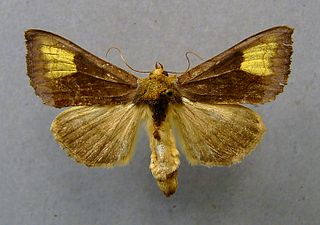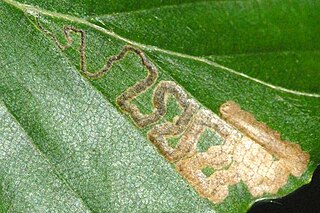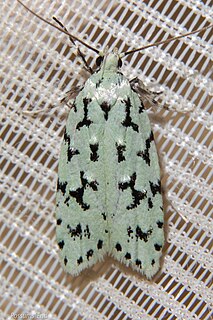Related Research Articles

Apamea crenata, known as the clouded-bordered brindle, is a moth in the family Noctuidae. It is distributed throughout the Palearctic realm. In the North it crosses the Arctic Circle, in the Mediterranean it is found only in cool locations and mountains avoiding very hot areas. In the Alps, it rises to an altitude of about 2000 metres.
Alpherakya sarta is a Palearctic species of lycaenid butterfly found in Afghanistan, Pakistan, Ghissar, Alai, Tian-Shan, Tarbagatai, Saur, South Altai and North India.

Protodeltote pygarga, the marbled white spot, is a species of moth of the family Noctuidae. It is found in the Palearctic realm.

Diachrysia chryson, the scarce burnished brass, is a moth of the family Noctuidae. The species was first described by Eugen Johann Christoph Esper in 1789. It is found in central and southern Europe, Asia Minor across the Palearctic to Japan.

Grammodes stolida, the geometrician, is a moth of the family Erebidae. The species was first described by Johan Christian Fabricius in 1775. It is found in Africa, southern Europe, most of Asia and Australia. It migrates to central and northern Europe as far north as England, Denmark and Finland.

Stigmella tityrella is a moth of the family Nepticulidae. It is found in all of Europe, except the European part of Russia.

Earophila badiata, the shoulder stripe, is a moth of the family Geometridae. The species was first described by Michael Denis and Ignaz Schiffermüller in 1775. It is found from most of Europe and North Africa to the Altai Mountains in the east Palearctic.
Tasmantrix thula is a moth of the family Micropterigidae. It is known from eastern Australia, where it is known from northern Queensland, from Devils Thumb and Mossman Gorge in the north to Mission Beach and from Herberton State Forest to Mission beach.

Conopomorpha flueggella is a moth of the family Gracillariidae. It is known from Tianjin, China.
Ypsolopha colleaguella is a moth of the family Ypsolophidae. It is known from the Volga River valley in southern Russia and Kazakhstan.

Izatha huttonii is a moth of the family Oecophoridae. It is endemic to New Zealand, where it is known from the Wellington district of the North Island, the South Island, and Stewart Island. Although similar in appearance to related species I. huttonii can be distinguished as it has a distinctive "M" shaped mark on its forewings. The larvae feed on the dead wood of makomako and karamu. Adult moths have been collected from October to March.
Hellinsia serenus is a moth of the family Pterophoridae. It is found in Arizona, Utah and California.

Singularia alternaria is a moth of the family Pterophoridae. It is found in Argentina, Chile and Ecuador.

Ichneutica morosa is a moth of the family Noctuidae. It is endemic to New Zealand and is found in the southern parts of the North Island and throughout the South Island. I. morosa is common in the eastern parts of both those islands and also in Fiordland. I. morosa can be found from altitudes ranging from lowlands to the alpine zone. I. morosa is absent from the range of its closely related species I. mustulenta, that is from the northern North Island. The larvae of I. morosa are known to feed on Poa astonii and also on other Poa species including introduced species. As well as its standard form the adult moths have a grey colour morph with the head and thorax being a grey and mottled brown, and the forewing being a pale greyish ochreous to a deep brown, suffused with grey. I. morosa can be confused with I. mustulenta and I. lignana. Adults are on the wing from November to April.

Hierodoris atychioides is a moth of the family Oecophoridae. It was described by Arthur Gardiner Butler in 1877. The female holotype specimen held at the Natural History Museum, London. This species is endemic to New Zealand, and can be found in the North, South and Stewart Islands. The larvae form webs of silk attached to frass and leaves on their hosts in which they shelter, often in the company of other larvae in their species. Their feeding habits have not been observed in detail but Hoare hypothesises the larvae may feed on dead or dying leaves. The larvae feed on a wide range of trees and shrubs, including Dacrydium cupressinum, Prumnopitys taxifolia, Dacrycarpus dacrydioides, Libocedrus bidwillii, Cupressus macrocarpa, Leptospermum scoparium, Kunzea ericoides, Ozothamnus leptophyllus, Abies, Picea, Pinus and Thuja species. Although they are regarded as a pest of exotic forests in New Zealand, the economic damage the larvae cause is minimal and they tend to be controlled only by their natural enemies. Larval enemies include the parasitic flies Trigonospila brevifacies and Pales funesta as well as parasitic wasps including Xanthopimpla rhopaloceros. The adult moths are day flying and are most common during the months of December and January. This species is variable in appearance as larvae, pupa and as adults, and it has been hypothesised that it is in the process of speciation.
Doina is a moth genus of the family Depressariidae.
Doina edmondsii is a moth in the family Depressariidae. It was described by Arthur Gardiner Butler in 1883. It is found in Chile.
Cerconota nitens is a moth in the family Depressariidae. It was described by Arthur Gardiner Butler in 1877. It is found in Brazil (Amazonas).
Eriogenes cossoides is a moth in the family Depressariidae. It was described by Arthur Gardiner Butler in 1882. It is found on the Moluccas, New Britain and Duke of York Island and in Queensland on mainland Australia.

Eriopygodes imbecilla, the Silurian, is a moth of the family Noctuidae first described by Johan Christian Fabricius in 1794.
References
- ↑ Savela, Markku. "Doina increta (Butler, 1883)". Lepidoptera and Some Other Life Forms. Retrieved August 14, 2019.
- ↑ Clarke, J. F. Gates (1978). "Neotropical Microlepidoptera, XXI: New Genera and Species of Oecophoridae from Chile" (PDF). Smithsonian Contributions to Zoology (273): 34.
- ↑ Transactions of the Entomological Society of London 1883 (1): 75